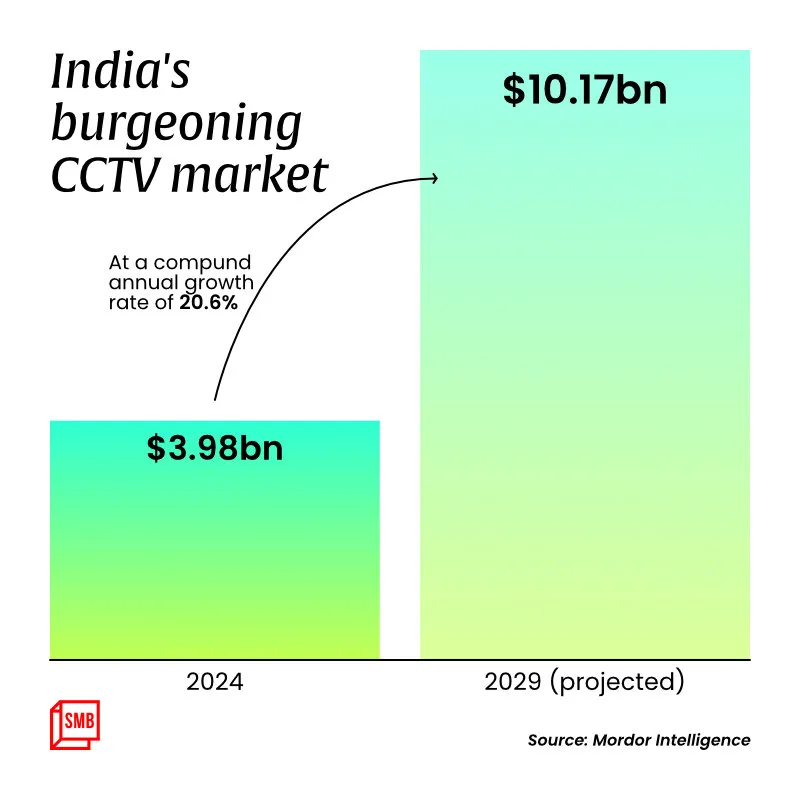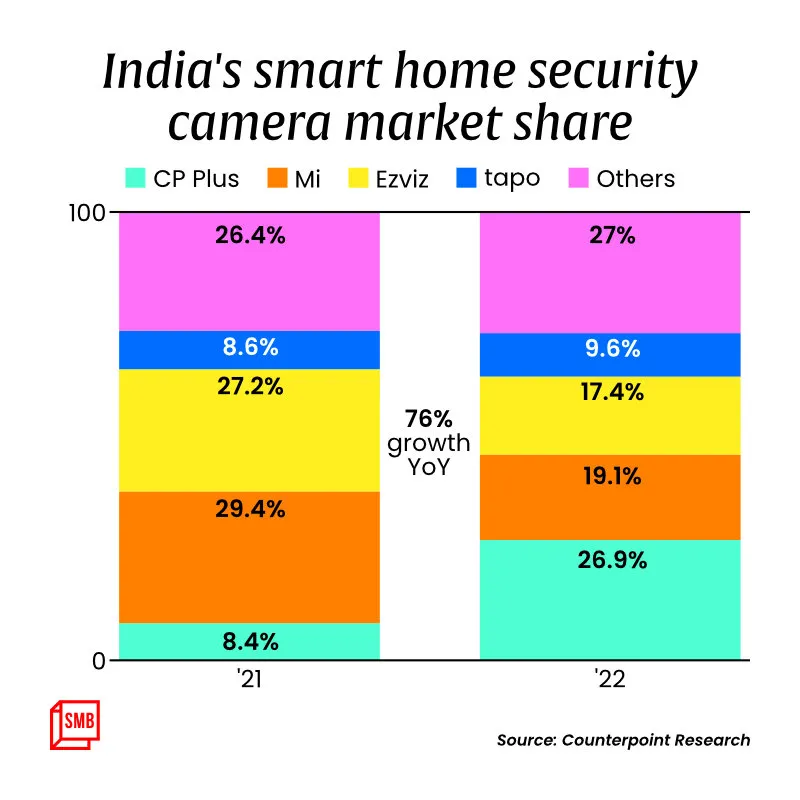Fighting China dominance, how Sparsh CCTV is emerging stronger
Sparsh CCTV has seen a lot of ups and downs in its business journey, but has managed to keep up with Chinese dominance. Today, it is an active part of the government's 5G movement. Here’s the journey of Sanjeev Sehgal, Founder and CEO of Sparsh CCTV, and how he built the company.
China’s dominance in the electronics industry is a well-known narrative. Around 2015, China significantly rattled the Indian electronics market, which led to the displacement of many industries in the country. With their aggressive pricing strategies, these firms flooded the Indian market and posed substantial challenges to existing businesses.
Companies in the CCTV (Closed Circuit Television) sector faced challenging times as well. Sparsh CCTV (Sparsh Securitech), under the parent company Samriddhi Automations Pvt Ltd, despite having an approximately 12% market share between 2010-2015, also faced difficulties due to China’s growing control over the sector.
Sanjeev Sehgal, Founder and CEO of Noida-based , who is also the founding Chairman of Security Promotion Group of India (SPGI) and Convener of Video Surveillance Committee on Indian Standards at BIS, representing India in IEC for video surveillance standard, says, Chinese companies then capitalised on economies of scale, offering cost-effective solutions that were hard to match for their Indian counterparts. However, the ecosystem in India has changed a lot in the present day in unexpected ways, he tells SMBStory.
The journey of Sparsh CCTV
An electronics engineer, Sehgal began his entrepreneurial stint in 1995 when he started a push button telephone manufacturing business with his friend.
He says, at the time, Beetel (present day Airtel) was among the few companies manufacturing push button telephones in India. “We started with a small investment of Rs 60,000. Our business was doing very well for a while, but cheap Chinese imports squeezed our profit margins significantly and pushed us out of this business,” he adds.
“I then tried my hands in the EPABX (electronic private automatic branch exchange) industry, and in three years, our company was a leading player in the market, with a network across India. Unfortunately, the partnership didn’t work out and I had to move out of the venture,” Sehgal says. He ran this set up till 2002, around the time when the CCTV market in India started to emerge.
“CCTV in the beginning was a luxury and only prominent business houses or families used to have these. Around 2002, I first began with the installation of CCTV cameras into client’s premises and from there the journey started,” Sehgal says.
Recalling an episode, Sehgal reminisces about the time when CCTV cameras were tethered to bulky systems on office desks via lengthy cables. While he was once installing cameras in an exporter’s office, the exporter was frustrated by the sprawling cables, and this sparked an idea in his mind. This proved to be a turning point in Sehgal’s journey.

“We were one of the first to develop homegrown remote operating switches for CCTV cameras and from there the manufacturing journey started,” says Sehgal.
Sparsh at that time also started making intruder alarm systems, audio/video door phone systems, and everything under one roof.
Sehgal claims that even in the early 2000s when every raw material for CCTV cameras was mostly imported, Sparsh’s remote-operated matrix switches were 21 times lower in cost compared to Chinese products.
Between 2010 and 2012, Sparsh had an approximate 12% market share in the then unorganised CCTV market, where Sehgal says the major push came, when with technical support from Sony Electronics, the company designed and manufactured one of the first indigenous cameras using Sony chipset, within 45 days.
Sehgal recalls and says, a comapny like Sony gave an order to a small company like ours (which was then making just Rs 2.5 crore in revenue) when major players like Tata and Honeywell existed. Maybe that was our time, but this order gave us a big boost, and in the next two-three years our business grew 11X.
Sparsh was doing a B2B business back then, but things took a bad turn in 2015 when China got a stronghold on global electronic manufacturing.
Sehgal highlights China's advanced infrastructure, expansive supply chain, and highly skilled workforce. Leveraging economies of scale, Chinese companies provided cost-effective solutions that proved challenging for their Indian counterparts to rival.
Gradually, Chinese companies like Hikvision, Dahua, and others made their entry into the Indian market, and with the persistent challenge of low price accompanied by the Indian mindset of not trusting homegrown companies, Sparsh’s business took a backseat.
“Whatever we had earned, we reinvested in the business and in R&D, but our B2B business went down,” Sehgal says.
But during that time, the ‘Make in India’ initiative was shaping up, and the government was backing and pushing homegrown companies. Sehgal didn’t miss out on the opportunity and pivoted to the government sector for the deployment of a security surveillance system and as they say, the rest is history.
Today, Sparsh CCTV has 200 SKUs, with a complete range of CCTV Solution, IoT devices, AI-based software, and accessories.
Now, Sparsh has been an active part of the 5G movement in India, which was demonstrated at IMC (Indian Mobile Congress) by presenting 20 5G use cases like facial recognition and railway driver alert system for railways and airports, intelligent traffic monitoring system for roadways, explosion proof cameras for mining and ONGC, thermal cameras for defence and body worn cameras for law enforcement.
In fact, during the COVID-19 pandemic, Sehgal converted Sparsh’s long rare thermal camera into fever detection camera and created around 17 models in 80 days, which were used at PM’s residence, hospitals, hotels, etc.
At the recently-held India Mobile Congress 2023, Sparsh launched an indigenous cloud platform. Sparsh was also present as an integrated solution for many booths—with L&T for manufacturing 4.0, as smart miner solution for Coal India, as vehicle path monitoring system for IIT Delhi, as facial recognition system for C-DoT, as railway solution for Ericsson proving to be a surveillance technological backbone for everyone.
CCTV industry in India
In response to the challenges of 2015, the Indian government has implemented various policy changes, incentives, and reforms. Programmes such as the Production-Linked Incentive (PLI) scheme have successfully enticed international companies to establish manufacturing hubs in India.

“Economic factors like China’s rising labour costs and economic shifts have led some companies to explore alternative manufacturing locations, and India has become an attractive destination. India has seen the emergence of a robust local manufacturing ecosystem with the growth of domestic companies and increased collaboration with global players,” says Sehgal.
Many homegrown brands have joined the fleet as well. In terms of competition, CP Plus has a 27% market share, according to Counterpoint Research, with its shipments quadrupling year-on-year. But Sehgal says Sparsh stands apart as it has an in-house R&D team of 40 people out of 350 overall employees.
Other renowned players like Xiaomi, EZVIZ by Hikvision, and Tapo by TP-Link have 19%, 17%, and 10% market share, respectively, as per Counterpoint Research. Sparsh CCTV currently has a market share of 2.5%, shares Sehgal.
According to Mordor Intelligence report, the India CCTV Market size is estimated at $3.98 billion in 2024, and is expected to reach $10.17 billion by 2029, seeing a CAGR of 20.60% during the forecast period.
India is still to level up in terms of CCTV and other allied products in the electronics industry. For Sparsh CCTV, 30% outsourcing still happens from outside India.
Keep up with times
In 2023, Sparsh entered the B2C segment.
“While challenges persist, India’s strategic initiatives and growing partnerships with global players indicate a positive trajectory. The journey from dependence to self-sufficiency is ongoing, and continued efforts will be crucial to establishing India as a formidable force in the global electronic manufacturing arena,” Sehgal says.
Sehgal wants Sparsh to become the backbone of the Indian Security Surveillance Industry and bring glory to Made in India products and solutions.
(The copy was updated to fix a factual error.)
Edited by Megha Reddy










